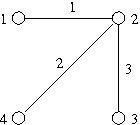
Zadanie Wyprawa (jou)
Pomóż nam usprawnić bazę zadań!
Journey
Memory limit: 32 MB
There are  cities in Byteland (numbered from
cities in Byteland (numbered from  to
to  ),
connected by bidirectional roads.
The king of Byteland is not very generous, so there are only
),
connected by bidirectional roads.
The king of Byteland is not very generous, so there are only
 roads, but they connect the cities in such a way that
it is possible to travel from each city to any other city.
roads, but they connect the cities in such a way that
it is possible to travel from each city to any other city.
One day, a traveller Byterider arrived in the city number  .
He was planning to make a journey starting in the city
.
He was planning to make a journey starting in the city  and
visiting on his way cities
and
visiting on his way cities  ,
,  , ...,
, ...,  (not necessarily in this order) - the numbers
(not necessarily in this order) - the numbers  are
all different and they are also different from
are
all different and they are also different from  .
Byterider - like every traveller - has only a limited amount of
money, so he would like to visit all the cities that he has
planned to visit
using the shortest possible path (starting in the city
.
Byterider - like every traveller - has only a limited amount of
money, so he would like to visit all the cities that he has
planned to visit
using the shortest possible path (starting in the city  ).
A path is one road or a sequence of roads, where every next road
begins in the city where the previous one ends.
Help Byterider to determine the length of the shortest path
for his journey.
).
A path is one road or a sequence of roads, where every next road
begins in the city where the previous one ends.
Help Byterider to determine the length of the shortest path
for his journey.
Task
Write a program which:-
reads from the standard input:
- the description of the roads connecting the cities of Byteland,
- the number of the city where Byterider arrived,
- a list of cities which Byterider would like to visit
- determines the minimum length of Byterider's journey,
- writes the result to the standard output
Input
The first line of the standard input contains two integers  and
and  separated by a single space (
separated by a single space ( ,
,  ),
),
 is the number of cities in Byteland
and
is the number of cities in Byteland
and  is the number of the first city on Byterider's path.
Each of the following
is the number of the first city on Byterider's path.
Each of the following  lines contains the description of one road
in Byteland.
Line
lines contains the description of one road
in Byteland.
Line  (for
(for  ) contains three integers
) contains three integers
 ,
,  and
and  separated by single spaces
(
separated by single spaces
( ,
,  ),
),
 and
and  are the cities connected by the road, and
are the cities connected by the road, and
 is the length of the road.
Line
is the length of the road.
Line  contains one integer
contains one integer  -
the number of cities which Byterider would like to visit
(
-
the number of cities which Byterider would like to visit
( ).
The next line contains
).
The next line contains  different integers
different integers  separated by single spaces -
the numbers of the cities that Byterider would like to visit
(
separated by single spaces -
the numbers of the cities that Byterider would like to visit
( ,
,  ).
).
Output
The first and only line of the standard output should contain exactly one integer: the length of the shortest path for Byterider's journey.
Example
For the input data:
4 2 1 2 1 4 2 2 2 3 3 2 1 3

the correct result is:
5
Task author: Jakub Radoszewski.
Kontakt
In the event of technical difficulties with Szkopuł, please contact us via email at [email protected].
If you would like to talk about tasks, solutions or technical problems, please visit our Discord servers. They are moderated by the community, but members of the support team are also active there.

 English
English